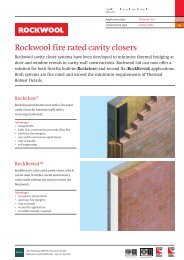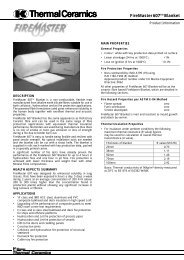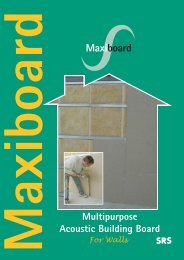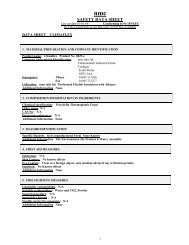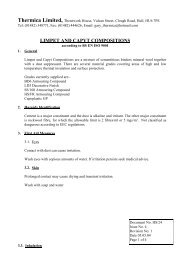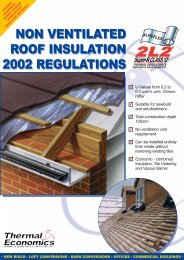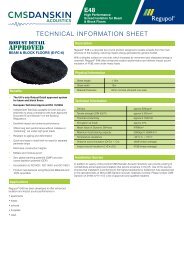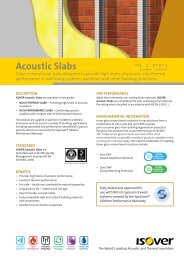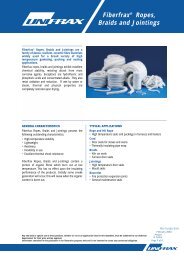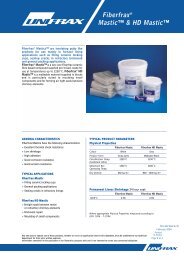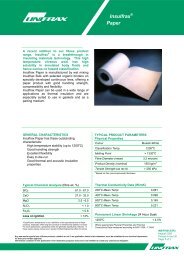Promat Flamebraker.pdf - SIG Technical Insulation
Promat Flamebraker.pdf - SIG Technical Insulation
Promat Flamebraker.pdf - SIG Technical Insulation
Create successful ePaper yourself
Turn your PDF publications into a flip-book with our unique Google optimized e-Paper software.
EXTERNAL WALLSThe Fire Protection Handbook5EXTERNAL WALLSFire Testing MethodsNon-loadbearing external walls should normally be tested orassessed in accordance with BS 476: Part 22: 1987 and arerequired to satisfy the failure criteria of integrity and insulationwhen exposed to fire from either side. In some instances therewill be additional criteria concerning the heat radiation from theunexposed face of the walls. For additional advice, pleaseconsult <strong>Promat</strong> <strong>Technical</strong> Services Department.Design ConsiderationsIn the case of external walls, the proximity of a building tothe relevant (facing) boundary determines the probabilityof it being a danger to other buildings on adjoining sitesor of it being at risk from a neighbouring building on fire.Building Regulations specify different fire resistance periods forexternal walls depending upon their distance from the relevantboundary. Where the walls are required to provide fireresistance only from the inside, loadbearing capacity andintegrity are required to be satisfied for the full period; whereasinsulation is required for only 15 minutes. This means thatsatisfactory constructions will be very different from thoserequired to maintain insulation for the full period and wherefire resistance is required from either side.The following points should be considered when determiningthe correct specification to ensure an external wall will providethe required fire performance. Further advice can be obtainedfrom <strong>Promat</strong> <strong>Technical</strong> Services Department.1. Distance from the Relevant BoundaryBuilding Regulations does sometimes relax therequirements for external walls which are one metre ormore from the relevant property boundary. In most casesthe wall only needs to be tested or assessed for itsperformance when exposed to fire from within the building.In addition, the maximum insulation period required is only15 minutes.2. External CladdingThe external cladding can significantly affect the overallfire performance of an external wall. For example, somecomposite external cladding panels with expanded plasticcores may perform much worse than a single skin steelsheet due to the low melting point of the core.3. Structural SteelAll structural steel within a fire protected external wallshould also be protected. This includes walls which mayonly require to be partially protected. If the steel frame ofa single storey building has not been designed inaccordance with the document, ‘Fire and steelconstruction: The behaviour of steel portal frames inboundary conditions, 1990’ (2 nd Edition) published by theSteel Construction Institute, the rafters of the roof may alsoneed protection as their collapse could lead to the collapseof the external wall.Generally, any steelwork located on the non-fire side ofa SUPALUX ® wall lining will be adequately fire protected.4. Single Storey BuildingsThe external walls of single storey buildings whichmay otherwise not require to be fire protected, maystill require to be protected if they are too close to therelevant boundary.5. Cavity BarriersBuilding Regulations specify where cavity barriersare required.6. Thermal <strong>Insulation</strong>U-values will depend upon the complete wall design.These U-values can be improved by the addition of moremineral wool. For additional information, please consult<strong>Promat</strong> <strong>Technical</strong> Services Department.7. Impact ResistanceSUPALUX ® is robust and reasonably impact resistant.Where there is risk of heavy impact however, and in mostcases below a height of 2m above floor level, it is advisableto introduce additional framing members as stiffening.Protection barriers or masonry walls up to 2m in heightare often advisable.8. Wind LoadingThe <strong>Promat</strong> systems offer good resistance to wind inducedinternal pressures. If there are predominant openings in theexternal envelope of the building however, the advice of<strong>Promat</strong> <strong>Technical</strong> Services Department should be sought.NOTE: Scottish Regulations may require different periods of fire insulation.THE PASSIVE FIRE PROTECTION HANDBOOKPROMAT UK LIMITED94




